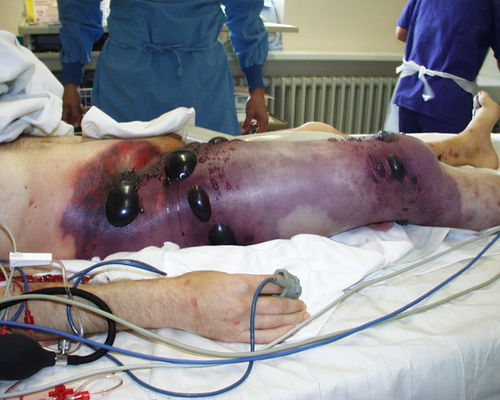The Role of Clostridium perfringens Toxins in Gas Gangrene: Difference between revisions
| Line 1: | Line 1: | ||
== | ==What is Gas Gangrene?== | ||
<br>By Marysol Arce<br> | |||
[[Image:Gas_gangrene.jpg|thumb|500px|right|A patient's right thigh severely affected by gas gangrene. Courtesy of Cases Journal, 2008, Vol. 1, Issue 252, published on BioMed Central (http://casesjournal.biomedcentral.com/articles/10.1186/1757-1626-1-252.]] | [[Image:Gas_gangrene.jpg|thumb|500px|right|A patient's right thigh severely affected by gas gangrene. Courtesy of Cases Journal, 2008, Vol. 1, Issue 252, published on BioMed Central (http://casesjournal.biomedcentral.com/articles/10.1186/1757-1626-1-252.]] | ||
Clostridium perfringens is a gram positive and rod shaped bacterium. It lives in anaerobic environments like the soil and inside the gut of humans and animals. There are five different strains of Clostridium perfringens: A, B, C, D, and E. The A strain is of the most importance because it causes gas gangrene, or myonecrosis, in humans. Gangrene is the death of body tissue and usually seen in elderly people or diabetic people. Open wounds that become infected by bacteria also become gangrenous. Gas gangrene is an especially dangerous form because it spreads quickly throughout the body if left untreated, and can be fatal. C. perfringens produces toxins that kills cells and releases gas, leaving parts of the body black, purple, and covered with blisters. | |||
<br><br>Other examples: | <br><br>Other examples: | ||
Revision as of 23:48, 21 April 2016
What is Gas Gangrene?
By Marysol Arce

Clostridium perfringens is a gram positive and rod shaped bacterium. It lives in anaerobic environments like the soil and inside the gut of humans and animals. There are five different strains of Clostridium perfringens: A, B, C, D, and E. The A strain is of the most importance because it causes gas gangrene, or myonecrosis, in humans. Gangrene is the death of body tissue and usually seen in elderly people or diabetic people. Open wounds that become infected by bacteria also become gangrenous. Gas gangrene is an especially dangerous form because it spreads quickly throughout the body if left untreated, and can be fatal. C. perfringens produces toxins that kills cells and releases gas, leaving parts of the body black, purple, and covered with blisters.
Other examples:
Bold
Italic
Subscript: H2O
Superscript: Fe3+
Introduce the topic of your paper. What is your research question? What experiments have addressed your question? Applications for medicine and/or environment?
A citation code consists of a hyperlinked reference within "ref" begin and end codes.
[1]
Section 1
Include some current research, with at least one figure showing data.
Every point of information REQUIRES CITATION using the citation tool shown above.
Section 2
Include some current research, with at least one figure showing data.
Section 3
Include some current research, with at least one figure showing data.
